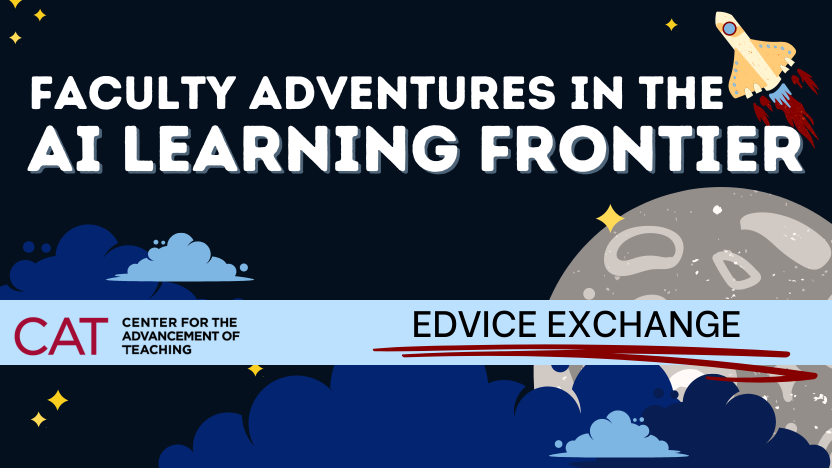by Jonah Chambers, MA and Cliff Rouder, EdD

As part of our fall 2023 survey on generative AI (GenAI) in the classroom, we heard back from a wide variety of Temple faculty who teach a broad range of courses. In this installment, we’re going to take a look at how three health science instructors are incorporating GenAI tools like ChatGPT into their teaching.
Scott Burns, Professor of Instruction in the Department of Health and Rehabilitation Sciences, had his graduate physical therapy students prompt ChatGPT to create a generic plan of care for a specific health condition and then provide a detailed explanation of how the exercises it prescribes may or may not properly address the condition described in the scenario under consideration. In addition to having students demonstrate their knowledge of what constitutes a good plan of care by evaluating and critiquing the AI-generated plan, Professor Burns explains that the goal of the activity is to highlight that while generative AI may be useful for broad recommendations, it “currently lacks the ability to provide decision-making and rationale backed by anatomy, neuroscience, motor control/learning, and physiology.”
Before he launched the assignment, Dr. Burns surveyed his class about their experiences with and perceptions of GenAI. He also wanted to gauge the level of anxiety surrounding it, given that there is concern in health-related fields that AI could replace the human provider. Students reported that they appreciated the opportunity to interact with AI, since the experience level with AI varied, and some had never even used it before. Dr. Burns plans to administer a more formal survey for the end of the semester to see if student perceptions of AI have shifted.
Alissa Smethers, Assistant Professor in the Department of Social and Behavioral Sciences, had her nutrition students prompt ChatGPT to create a 1-day, 2,000 kcal dietary pattern for a popular diet of their choice (Keto, Paleo, Atkins, etc.) and then submit the outputs to an established dietary analysis program and answer the following questions:
- Does the plan provide 2000 kcal? If not, how far off was it?
- Does the macronutrient composition and food choices reflect the popular diet you chose? If not, what foods would you add/remove?
Her students were surprised at how far off ChatGPT was at times, in some cases generating plans that differed by over 800 kcal from what the dietary analysis program provided. The goal was not only to ensure that students are learning the correct information but also that they develop critical thinking and research skills crucial to their work as nutrition professionals. In the future, she is considering having students evaluate how well ChatGPT is able to tailor the dietary patterns based on culture, income level, or other more personalized factors as well as reflect on the limitations of using a generative AI tool to create dietary patterns vs. working with a nutrition professional like a Registered Dietitian.
Leah Schumacher, Assistant Professor in the Department of Social and Behavioral Sciences, invited Health Science and Human Behavior students to roleplay as someone who either wants to avoid or already has a chronic disease and has turned to ChatGPT to provide answers or advice. She first asked students to pick one of the diseases they covered in her class and then pose questions about it to ChatGPT such as “Why did I have a stroke?” or “How do I avoid getting cancer?” She then had students prepare a submission for the assignment that included:
- The full prompt they submitted to ChatGPT
- The full response ChatGPT provided
- A short 5-7-sentence reflection that compared the ChatGPT response to what they had learned in class through textbook readings, lectures, videos, etc. Specifically, she asked students to reflect upon the extent to which ChatGPT’s response hit upon aspects of the biopsychosocial model they studied in class, whether it touched upon major risk factors they covered, and if ChatGPT presented any information that was new to them.
Dr. Schumacher was careful to have students clearly distinguish between text generated by ChatGPT and their own written work in their submission. Not only did this assignment have students apply their understanding of the biopsychosocial model to a diverse set of cases, it also gave them the opportunity to reflect upon (and illuminate problematic aspects of) how people may use ChatGPT in their everyday lives.
Each of these professors has illuminated one of the most powerful ways of using GenAI in teaching: instead of taking its outputs at face value, they have their students question, evaluate, analyze and verify them using a variety of methods. Not only does this provide students an opportunity to apply their knowledge (a proven way to promote deep learning), but it also helps them sharpen their critical thinking skills surrounding the use of GenAI. These skills will likely not only prove helpful to them now but also in their future professional lives.
In the next installment, we’ll be looking at ethics in AI. In the meantime, if you’d like more guidance on exploring how to use AI tools in your class or assistance running your assignments through GenAI to better assess the value of using it, please visit our Faculty Guide to A.I., attend a workshop on using generative AI for teaching and learning, or book an appointment for a one-on-one consultation.